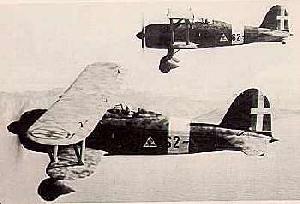

The CR.42 Falco (Falcon) was the last of the great biplane fighters entering flight
testing in late May 1938. It was a successor of CR.32 that had claimed great success
in the Spanish skies during the civil war.
The CR.42 was manufactured in larger numbers than any other Italian fighter, remaining
in production as late as 1943. Extremely light on the controls, universally viewed as
a delight to fly, superbly agile and innately robust, the CR.42 synthesised a
decade-and-a-half of continuos fighter development; it was a thoroughbred with
a distinguished pedigree carrying fighter biplane evolution to its apex. But its
intrinsic qualities were those demanded of an earlier era in aerial warfare than
that in which it was to find itself. The CR.42 was nevertheless to see combat
throughout WWII and, curiously, was to fight against the Luftwaffe, alongside the
Luftwaffe and with the Luftwaffe itself, singing the swan song of the fighter biplane
while doing so.
The CR.42 was exported to Belgium, Sweden and Hungary, seeing combat in both Belgium
and Hungary. Regia Aeronautica used them on all fronts (e.g. North Africa,
Mediterranean, Battle of Britain and East Africa).
The Luftwaffe used more than 100, as night attack aircraft in relatively quiet theatres and as fighter-trainers.
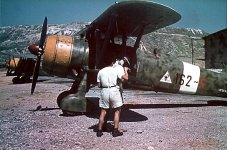
The CR.42 saw service in: Belgium (23), Germany (100+), Hungary (72), Italy (IAF, RSIAF, IcoAF), South Africa (2 captured ex-Italian), Sweden (72)
Total production: 1780+
Technical details
Type:__________Fighter and Reconnaissance
Span:__________9.7 m
Length:________8.25 m
Engine:________Fiat A.74 RC 38 / 840 hsp
Max speed:_____430 km/h
Max ceiling:___10200 m
Range:_________775 km
Armament:______2x12.7 mm machine guns + 200 kg of bombs
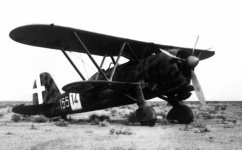
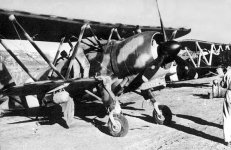
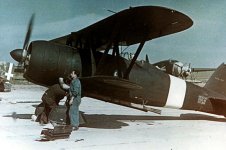
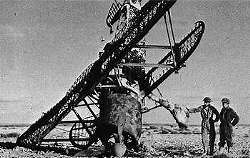
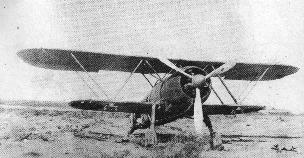
The famous test-pilot Captain Eric M. Brown, RN, had an opportunity to fly the
captured CR.42 MM5701, which was captured after a
forced-landing in the later stages of Battle of Britain. He reported that the
aircraft was an aerobatic gem. It was remarkably fast for a biplane with a top
speed of 270 mph at 12,400 ft and a marginal stability, the hallmark of a good
fighter. The CR.42 was a superb biplane that gave an outstanding performance for
its type, but as a fighter it was under-gunned. Though highly manoeuvrable, like
all aircraft with a lot of fabric covering it was very vulnerable to enemy fire.
Source:
The Fiat CR.42 in Regia Aeronautica service
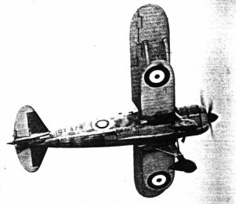
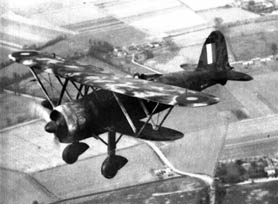
MM5701 while under test by the RAF.
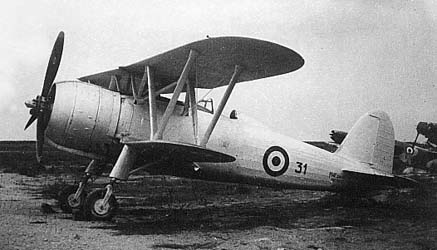
A very rare post-war photo taken in 1946-47 probably at Lecce Flying School of one of
the last surviving CR.42s still in service in Italy. Notice the overall
silver finish, the OD anti-glare area painted in front of the cockpit and
the engine, the lack of both spinner cap and wheel spats.
© Archive D'Amico-Valentini.
Image kindly via Ferdinando D'Amico.
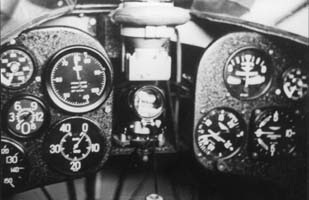
Cockpit instrumentation.
Image kindly via Peter Taghon.
Combat Aircraft of World War Two - Elke C. Weale, 1985
Courage Alone - Chris Dunning, 1998
Duels in the sky - Eric M. Brown, 1988
Air Enthusiast/Twenty
Swedish Air Force use of the Fiat CR.42 Falco
The Falco in the Battle of Britain
Fiat CR.42s and Gloster Gladiators over Malta 1940-42
The Fiat CR.42 in the Belgian Air Force service during the Second World War
The Fiat CR.42 in the Free French Air Force service during the Second World War
The Fiat CR.42 in the Hungarian Air Force service during the Second World War
The Fiat CR.42 in the Luftwaffe service during the Second World War
The Fiat CR.42 in South African Air Force service during the Second World War


